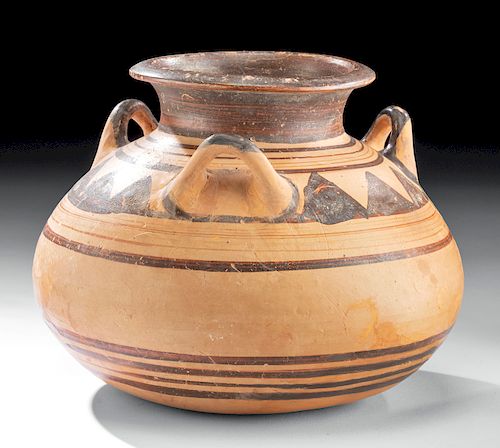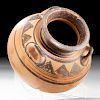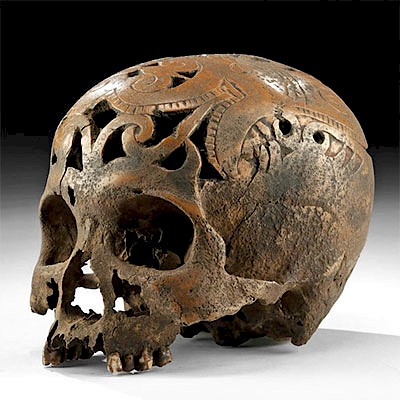Late Mycenaean Pottery Three Handled Pyxis w/ TL
Lot 26b
About Seller
Artemis Fine Arts
686 S Taylor Ave, Ste 106
Louisville, CO 80027
United States
Selling antiquities, ancient and ethnographic art online since 1993, Artemis Gallery specializes in Classical Antiquities (Egyptian, Greek, Roman, Near Eastern), Asian, Pre-Columbian, African / Tribal / Oceanographic art. Our extensive inventory includes pottery, stone, metal, wood, glass and textil...Read more
Categories
Estimate:
$2,000 - $3,000
Absentee vs Live bid
Two ways to bid:
- Leave a max absentee bid and the platform will bid on your behalf up to your maximum bid during the live auction.
- Bid live during the auction and your bids will be submitted real-time to the auctioneer.
Bid Increments
| Price | Bid Increment |
|---|---|
| $0 | $25 |
| $300 | $50 |
| $1,000 | $100 |
| $2,000 | $250 |
| $5,000 | $500 |
| $10,000 | $1,000 |
| $20,000 | $2,500 |
| $50,000 | $5,000 |
| $100,000 | $10,000 |
| $200,000 | $20,000 |
About Auction
By Artemis Fine Arts
Dec 12, 2019
Set Reminder
2019-12-12 10:00:00
2019-12-12 10:00:00
America/New_York
Bidsquare
Bidsquare : Holiday Sale - Antiquities / Ethnographic Art
https://www.bidsquare.com/auctions/artemis-gallery/holiday-sale---antiquities-ethnographic-art-4743
What to give this holiday season? You'll find plenty of options in our Dec. 12 auction that will cater to all tastes and budgets. Artemis Fine Arts info@artemisgallery.com
What to give this holiday season? You'll find plenty of options in our Dec. 12 auction that will cater to all tastes and budgets. Artemis Fine Arts info@artemisgallery.com
- Lot Description
**Holiday Shipping Deadlines**
USA Domestic: 12/14 for Standard; 12/23 for Express; International: 12/7 for Standard; 12/19 for Express
Ancient Greece, late Sub-Mycenaean to early Archaic period, ca. 900 to 700 BCE. A wonderful pyxis of a sizable form with a slightly concave base, a spherical body with a gently carinated midsection, a sloped shoulder bedecked with a trio of parabolic handles, a squat neck, and an everted rim surrounding the deep basin. The pale orange-slipped exterior is accentuated with red-brown pigment that forms concentric rings, solid panels, and a register of repeating triangles on the shoulder. Size: 7.1" W x 5.6" H (18 cm x 14.2 cm)
This period is so named for the palace at Mycenae, famed in Homeric legend as the opulent seat of King Agamemnon. Excavations at the palace at Mycenae revealed an elite and long-lasting society with a great deal of wealth. This extended to the workshops of artisans who produced pottery like this vessel both for use in Greece and throughout the Mediterranean world; shiploads of similar jars went out as far as the Levant and Spain, carrying oil, wine, and other commodities.
This piece has been tested using thermoluminescence (TL) analysis and has been found to be ancient and of the period stated. A full report will accompany purchase.
Provenance: ex-collection of Gregory Loles, Connecticut, USA, acquired in 1989
All items legal to buy/sell under U.S. Statute covering cultural patrimony Code 2600, CHAPTER 14, and are guaranteed to be as described or your money back.
A Certificate of Authenticity will accompany all winning bids.
We ship worldwide and handle all shipping in-house for your convenience.
#147811Professionally repaired from multiple large pieces, with areas of restoration to base, body, and handles, with resurfacing and overpainting along new material and break lines. Abrasions and nicks to exterior, with light fading to original pigmentation, and light encrustations within basin. Nice traces of original pigmentation throughout with great craquelure. Two TL drill holes: one beneath base, and one beneath rim exterior.Condition
- Shipping Info
-
All shipping is handled in-house for your convenience. Your invoice from Artemis Gallery will include shipping calculation instructions. If in doubt, please inquire BEFORE bidding for estimated shipping costs for individual items.
-
- Buyer's Premium



 EUR
EUR CAD
CAD AUD
AUD GBP
GBP MXN
MXN HKD
HKD CNY
CNY MYR
MYR SEK
SEK SGD
SGD CHF
CHF THB
THB















